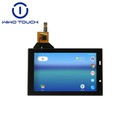As technology continues to advance, the aviation industry is also constantly being updated, with touch screens being used more and more widely in aviation. Touch technology displays are used in aircraft equipment, and by touching the screen, users can complete various commands and controls on the equipment.
Features of touch screens
1. Good display effect
The sky is a complex environment, the light is dark, for this reason, aviation touch screen in the design must be considered a good display effect. Aviation touch screen using high-definition LCD, with high resolution and high brightness characteristics, not only to meet the needs of complex weather conditions, but also to optimize the user experience.
2. Safety and reliability
As one of the important parts of the aircraft, aviation touch screen must have a high degree of security, only under the premise of ensuring the safety of the use. Aviation touch screens require fast command response and no problems such as accidental touches to ensure the stability and safety of the aircraft.
3. Fast response time
Aviation touch screens are responsive and can quickly reflect user commands, improving the responsiveness of the aircraft and providing faster and better flight control services.
4. Multi-touch
Fingers can touch multiple locations on the screen at the same time, this mode of operation can achieve multi-player collaborative control and view multiple flight parameters at the same time.
Advantages of touch screens
1. Improved ease of operation
The use of aviation touch screen, through the intuitive operation interface can be more convenient and fast to complete a variety of instructions and queries, eliminating the inconvenience of many operating procedures.
2. Reduce the need for equipment maintenance
Compared to traditional mechanical interface control methods, aviation touch screens are less costly to maintain, because they have no mechanical parts and do not come into contact with mechanical components that can be damaged, reducing the cost of equipment maintenance.
3. Small size, space saving
The small overall size of the aviation touch screen can greatly save space in the cabin, which makes the cabin more spacious and comfortable.
4. Data can be transparent
Aerial touchscreens can be integrated into aviation systems to enable data interaction with other devices. By capturing data, the flight status can be reflected more visually, promoting transparency of flight data and improving flight safety.
5. Good display effect
Thanks to the high-definition LCD, the display of the aviation touch screen is very good. It can clearly display flight data in extreme environments and provide a stable information display and operating interface in poor weather and uneven light conditions, which is unmatched by traditional interface devices.
6. Adapt to high-speed flight
The aviation touch screen has the ability to respond quickly and adapt to high-speed flight environments, so you can navigate high-speed aircraft to carry out work.
7. Easy to upgrade
With the continuous progress of technology, aviation touch screen applications are becoming more and more widespread. Different users require different functional surfaces, can be for different user needs, through the upgrade or update software to increase or modify the function to meet the needs of different customers.
8. Improve functional integration
Aviation touch screen system software can be integrated with other systems to improve the coupling of the systems. Aviation touch screen has basic and extended functions, and as the functions continue to expand, the whole system is becoming more and more complete.





